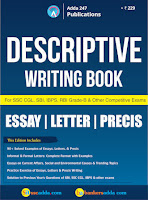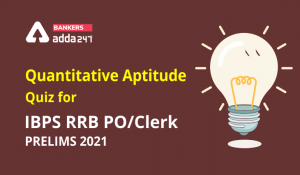Dear students,
Numerical Ability for SBI Clerk Prelims 2018
Today is the Day 20 of the SBI Clerk 60 Days Study Plan and the topic for Today’s Numerical Ability or Quantitative Aptitude Practice Questions is Based on Misclleneous. Numerical Ability Section has given heebie-jeebies to the aspirants when they appear for a banking examination. As the level of every other section is only getting complex and convoluted, there is no doubt that this section, too, makes your blood run cold. The questions asked in this section are calculative and very time-consuming. But once dealt with proper strategy, speed, and accuracy, this section can get you the maximum marks in the examination. Following is the Numerical Ability quiz to help you practice with the best of latest pattern questions.
Q1. Ramesh rows in still water with a speed of 4.5 kmph to go to a certain place and comes back. Find his average speed for the whole journey, if the river is flowing with a speed of 1.5 kmph.
(a) 4 kmph
(b) 3 kmph
(c) 2 kmph
(d) 1.5 kmph
(e) 2.5 kmph
Q2. A boat running upstream covers a distance of 10 km in 30 min and while running downstream, it covers the same distance in 25 min. What is the speed of the river current (in kmph)?
(a) 20 kmph
(b) 2.2 kmph
(c) 2 kmph
(d) 4 kmph
(e) 3.5kmph
Q3. A boat goes from A to B downstream in 1 hour, while it comes back from B to A in 3/2 hours. If the speed of the stream be 3 kmph, what is the speed of the boat in still water
(a) 12 kmph
(b) 13 kmph
(c) 14 kmph
(d) 15 kmph
(e) 10 kmph
Q4. Two trains are running with speeds 30 kmph and 58 kmph respectively in the same direction. A man in the slower train passes the faster train in 18 seconds. Find the length (in metres) of the faster train is:
(a) 70 m
(b) 100 m
(c) 128 m
(d) 140 m
(e) 120 m
Q5. A train covers a distance between station A and station B in 45 minutes. If the speed of the train is reduced by 5 kmph, then the same distance is covered in 48 minutes. The distance between stations A and B is:
(a) 60 km
(b) 64 km
(c) 80 km
(d) 55 km
(e) 50 km
Q6. A bike travels a distance of 200 km at a constant speed. If the speed of the bike is increased by 5 km an hour, the journey would have taken 2 hours less. What is the original speed of the bike?
(a) 30 kmph
(b) 25 kmph
(c) 20 kmph
(d) 15 kmph
(e) 18 kmph
Q7. A man covers a certain distance from A to B on scooter. Had he moved 2 kmph faster, he would have taken 1 hour less. If he had moved 2 kmph slower, he would have taken 2 hours more. Find the distance between A to B:
(a) 20 km
(b) 24 km
(c) 22 km
(d) 40 km
(e) 48 km
Q8. If 1 men or 2 women or 3 boys can complete a piece of work in 88 days, then 1 man, 1 woman and 1 boy together will complete it in
(a) 36 days
(b) 42 days
(c) 48 days
(d) 54 days
(e) 56 days
Q9. 2 men and 3 women can do a piece of work in 10 days while 3 men and 2 women can do the same work in 8 days. Then 2 men and 1 woman can do the same work in
(a) 12 days
(b) 25/2 days
(c) 13 days
(d) 27/2 days
(e) 14 days
Q10. A and B alone can do a piece of work in 20 days and 12 days respectively. A started the work alone and then after 4 days B joined him till the completion of the work. How long did the work last?
(a) 10 days
(b) 20 days
(c) 15 days
(d) 6 days
(e) 18 days
Q11. Five liters are drawn off from a vessel full water and substituted by pure milk. Again, five liters of the mixture is drawn off and substituted by pure milk. If the vessel now contains milk and water in the ratio 16: 9, find the capacity of the vessel.
(a) 25 liters
(b) 6.25 liters
(c) 12.5 liters
(d) 30 liters
(e) 35 liters
Q12. In a 50 litre mixture of water and milk, water is only 20%. The milkman gives 10 litres of this mixture to a customer and then he adds up 10 litres of pure water in the remaining mixture. The percentage of water in the final mixture is:
(a) 84%
(b) 74%
(c) 26%
(d) 36%
(e) 46%
Q13. The ratio of petrol and kerosene in the container is 3 : 2 when 10 liters of the mixture is taken out and is replaced by the kerosene, the ratio becomes 2 : 3. The total quantity of the mixture in the container is:
(a) 25 L
(b) 30 L
(c) 45 L
(d) Cannot be determined
(e) 55 L
Q14. In what ratio must a person mix three kinds of tea that cost Rs. 50 /kg, Rs. 70 /kg and Rs. 90 /kg respectively, so that if the resultant mixture when sold at Rs. 80 /kg yields a profit of 25%.
(a) 20 : 3 : 7
(b) 14 : 3 : 13
(c) 16 : 7 : 7
(d) 15 : 6 : 7
(e) 11: 13: 17
Q15. How many kg of salt at 25 paise per kg must be mixed with 50 kg of salt costing 42 paise per kg so that a merchant will get a profit of 30% by selling the mixture at 39 paise per kg?
(a) 179.2 kg
(b) 120 kg
(c) 175 kg
(d) 150 kg
(e) 160 kg
Q1. Ramesh rows in still water with a speed of 4.5 kmph to go to a certain place and comes back. Find his average speed for the whole journey, if the river is flowing with a speed of 1.5 kmph.
(a) 4 kmph
(b) 3 kmph
(c) 2 kmph
(d) 1.5 kmph
(e) 2.5 kmph
Q2. A boat running upstream covers a distance of 10 km in 30 min and while running downstream, it covers the same distance in 25 min. What is the speed of the river current (in kmph)?
(a) 20 kmph
(b) 2.2 kmph
(c) 2 kmph
(d) 4 kmph
(e) 3.5kmph
Q3. A boat goes from A to B downstream in 1 hour, while it comes back from B to A in 3/2 hours. If the speed of the stream be 3 kmph, what is the speed of the boat in still water
(a) 12 kmph
(b) 13 kmph
(c) 14 kmph
(d) 15 kmph
(e) 10 kmph
Q4. Two trains are running with speeds 30 kmph and 58 kmph respectively in the same direction. A man in the slower train passes the faster train in 18 seconds. Find the length (in metres) of the faster train is:
(a) 70 m
(b) 100 m
(c) 128 m
(d) 140 m
(e) 120 m
Q5. A train covers a distance between station A and station B in 45 minutes. If the speed of the train is reduced by 5 kmph, then the same distance is covered in 48 minutes. The distance between stations A and B is:
(a) 60 km
(b) 64 km
(c) 80 km
(d) 55 km
(e) 50 km
Q6. A bike travels a distance of 200 km at a constant speed. If the speed of the bike is increased by 5 km an hour, the journey would have taken 2 hours less. What is the original speed of the bike?
(a) 30 kmph
(b) 25 kmph
(c) 20 kmph
(d) 15 kmph
(e) 18 kmph
Q7. A man covers a certain distance from A to B on scooter. Had he moved 2 kmph faster, he would have taken 1 hour less. If he had moved 2 kmph slower, he would have taken 2 hours more. Find the distance between A to B:
(a) 20 km
(b) 24 km
(c) 22 km
(d) 40 km
(e) 48 km
Q8. If 1 men or 2 women or 3 boys can complete a piece of work in 88 days, then 1 man, 1 woman and 1 boy together will complete it in
(a) 36 days
(b) 42 days
(c) 48 days
(d) 54 days
(e) 56 days
Q9. 2 men and 3 women can do a piece of work in 10 days while 3 men and 2 women can do the same work in 8 days. Then 2 men and 1 woman can do the same work in
(a) 12 days
(b) 25/2 days
(c) 13 days
(d) 27/2 days
(e) 14 days
Q10. A and B alone can do a piece of work in 20 days and 12 days respectively. A started the work alone and then after 4 days B joined him till the completion of the work. How long did the work last?
(a) 10 days
(b) 20 days
(c) 15 days
(d) 6 days
(e) 18 days
Q11. Five liters are drawn off from a vessel full water and substituted by pure milk. Again, five liters of the mixture is drawn off and substituted by pure milk. If the vessel now contains milk and water in the ratio 16: 9, find the capacity of the vessel.
(a) 25 liters
(b) 6.25 liters
(c) 12.5 liters
(d) 30 liters
(e) 35 liters
Q12. In a 50 litre mixture of water and milk, water is only 20%. The milkman gives 10 litres of this mixture to a customer and then he adds up 10 litres of pure water in the remaining mixture. The percentage of water in the final mixture is:
(a) 84%
(b) 74%
(c) 26%
(d) 36%
(e) 46%
Q13. The ratio of petrol and kerosene in the container is 3 : 2 when 10 liters of the mixture is taken out and is replaced by the kerosene, the ratio becomes 2 : 3. The total quantity of the mixture in the container is:
(a) 25 L
(b) 30 L
(c) 45 L
(d) Cannot be determined
(e) 55 L
Q14. In what ratio must a person mix three kinds of tea that cost Rs. 50 /kg, Rs. 70 /kg and Rs. 90 /kg respectively, so that if the resultant mixture when sold at Rs. 80 /kg yields a profit of 25%.
(a) 20 : 3 : 7
(b) 14 : 3 : 13
(c) 16 : 7 : 7
(d) 15 : 6 : 7
(e) 11: 13: 17
Q15. How many kg of salt at 25 paise per kg must be mixed with 50 kg of salt costing 42 paise per kg so that a merchant will get a profit of 30% by selling the mixture at 39 paise per kg?
(a) 179.2 kg
(b) 120 kg
(c) 175 kg
(d) 150 kg
(e) 160 kg





 Quantitative Aptitude Quiz For IDBI AM/E...
Quantitative Aptitude Quiz For IDBI AM/E...
 Quantitative Aptitude Quiz For IBPS RRB ...
Quantitative Aptitude Quiz For IBPS RRB ...





